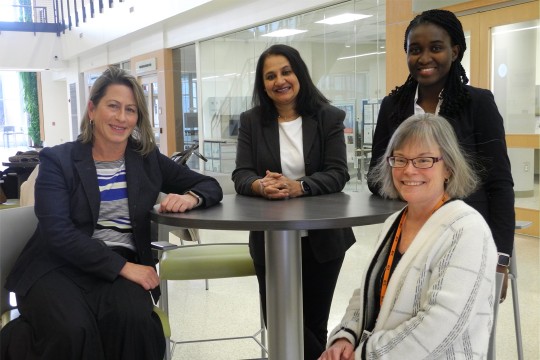Architectural and Civil Drafting Technology Associate in Applied Science Degree

Architectural and Civil Drafting Technology
Associate in Applied Science Degree
- RIT /
- Rochester Institute of Technology /
- Academics /
- Architectural and Civil Drafting Technology AAS
Blueprint your career with an AAS program in Architectural and Civil Drafting Technology. Design the structures of tomorrow.
Overview for Architectural and Civil Drafting Technology AAS
People who work in architectural and civil drafting technology use their skills to create two- and three-dimensional drawings on the computer. These drawings are used to visually represent buildings, bridges, canals, and houses. This program is available for qualified deaf and hard of hearing students.
The associate in applied science (AAS) in architectural and civil drafting technology, offered by RIT's National Technical Institute for the Deaf, will prepare you for a rewarding career as a CAD technician. The program provides you with the skills to become a support technician in the architecture, engineering and construction field. You might work with architects or engineers on projects such as buildings, highways, or bridges. Construction companies and building suppliers also hire CAD technicians.
CAD operators, also called CAD technicians, take the sketches of an engineer, architect, or designer and produce a set of technical drawings. In addition to a strong emphasis on computer-aided drafting, the major provides you with a background in mathematics, building systems, construction regulations, site utilities, and materials and methods used in the architecture, engineering, and construction industries.
The AAS degree in architectural and civil drafting technology prepares students to find immediate employment upon graduation or to continue their education by working towards a bachelor’s degree. Transfer requirements into RIT’s bachelor degree programs vary by program.
-
Apply by January 15 for Fall 2026
Get your first-year application in and receive a decision by mid-March.
Careers and Cooperative Education
Typical Job Titles
| Drafter | Technician |
Industries
-
Civil Engineering
-
Construction
-
Government (Local, State, Federal)
-
Architecture and Planning
Cooperative Education
What’s different about an RIT education? It’s the career experience you gain by completing cooperative education and internships with top companies in every single industry. You’ll earn more than a degree. You’ll gain real-world career experience that sets you apart. It’s exposure–early and often–to a variety of professional work environments, career paths, and industries.
Students in the architectural and civil drafting technology program are required to complete a cooperative education work experience prior to graduation. You may schedule your co-op after completing your second-year academic requirements.
Curriculum for 2025-2026 for Architectural and Civil Drafting Technology AAS
Current Students: See Curriculum Requirements
Admissions and Financial Aid
For the career-focused AAS degree
- 2 years of math required
- 1 year of science required
- English language skills as evidenced by application materials determine associate degree options.
Specific English, mathematics, and science requirements and other recommendations
- English: Placement into NENG-121 Bridge to Academic Literacies or above, including into a University Writing (UWRT) course. To earn the AAS degree, students must complete all necessary English coursework through UWRT-150 FYW: Writing Seminar.
- Mathematics: Placement in Trigonometry (NMTH-220). Typically, students entering this program will have completed at least three years of high school mathematics.
- Science: Placement into Principles of Physics (NSCI-201) or a higher level course. Typically, students entering this program will have completed at least three years of high school science. High school physics would be beneficial.
- ACT (optional): The ACT middle 50% composite score is 14-17.
Financial Aid and Scholarships
100% of all incoming first-year and transfer students receive aid.
RIT’s personalized and comprehensive financial aid program includes scholarships, grants, loans, and campus employment programs. When all these are put to work, your actual cost may be much lower than the published estimated cost of attendance.
Learn more about financial aid and scholarships
Accreditation
Related News
-
November 28, 2022

Research team awarded grant from NIST to develop new standards-based educational modules
A team of researchers from RIT was recently awarded a grant to develop curricular modules on infrastructure improvement and resilience that introduce students to public and private sector standards, including industry standards.
-
August 6, 2018

Not quite love at first sight for RIT couple
Brianna Schlitt ’11, ’13 and Brynjar Leifsson ’11, ’13 thought it was love at first sight when they met on the RIT campus in 2009. But they later learned they had attended the same elementary school, shared some of the same teachers and even ate lunch together there.
Contact
- Karen Beiter
- Interim Department Chair
- National Technical Institute for the Deaf
- 585‑286‑4546
- kjbndp@rit.edu
Department of Engineering Studies














